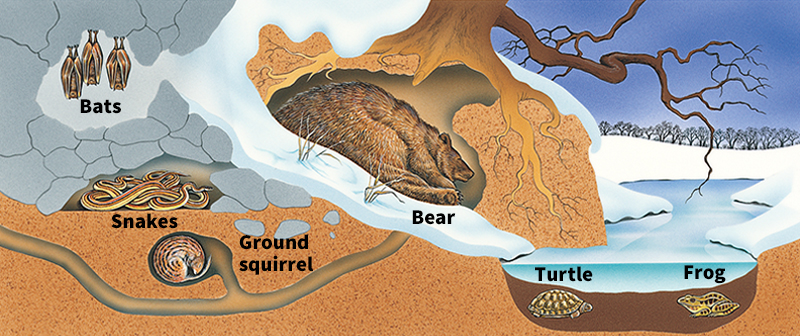Hibernation is an inactive, sleeplike state that some animals enter during the winter. Animals that hibernate protect themselves against the cold and reduce their need for food. A hibernating animal’s body temperature is lower than normal, and its heartbeat and breathing slow down greatly. An animal in this state needs little energy to stay alive and can live off fat stored in its body. Thus, hibernating animals can more easily survive cold winters when food is scarce.

Warm-blooded hibernators
include such birds as nighthawks and swifts; and such mammals as bats, chipmunks, ground squirrels, hamsters, hedgehogs, fat-tailed lemurs, and marmots. Most of these animals eat large amounts of food in the fall. The food is stored in the animals’ bodies as fat, which provides energy during hibernation. Hibernating birds and mammals do not sleep straight through the winter. Instead, these animals experience several bouts—periods of deep hibernation—that alternate with periods of wakefulness. They are able to arouse themselves from hibernation at any time and may also be aroused by heat. A few hibernators store food in their caves or burrows. They eat this food between bouts.
Some bears experience a period of dormancy (inactivity) during the winter that is characterized by a prolonged sleep. Scientists disagree on whether or not this winter sleep is true hibernation. Many scientists do not classify bears as hibernators because a bear’s body temperature falls only slightly during dormancy. The scientists also point out that bears are easily aroused from their winter sleep. Many other scientists, however, believe that bears are true hibernators. They argue that a bear’s heart rate drops to less than half of normal during winter sleep, and that the bear’s rate of metabolism also falls significantly. Metabolism is the process by which living things turn food into energy. These scientists think that bears have a high body temperature when dormant because their large bodies do not lose as much heat, relative to the heat generated by their metabolism, as do the smaller bodies of other hibernators.
Cold-blooded hibernators
include such amphibians as frogs and salamanders and such reptiles as lizards, snakes, and turtles. The body temperature of these animals rises and falls with the temperature of the environment. When cold weather causes their body temperature to drop, the animals enter hibernation. An amphibian or reptile can only be aroused from hibernation when its environment warms up enough to heat its body.
Other kinds of dormancy.
Some species of bats are dormant each day and active each night. Some birds, such as hummingbirds, are active during the day and dormant at night. These types of dormancy are known as diurnal torpidity. Some animals become dormant in the summer to protect themselves from heat and drought. This type of dormancy is called estivation. Many insects experience diapause, a period of inactivity and lack of growth. Diapause can occur in any season. When it occurs during the winter, it is sometimes called hibernation.
